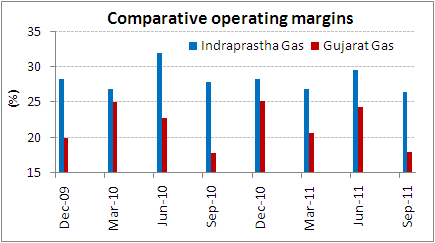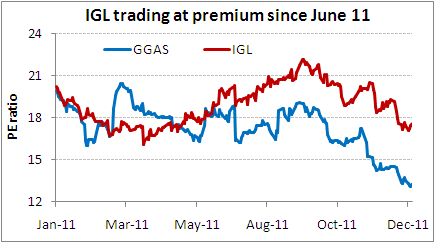In the previous article, we had discussed some operational aspects of the two leading city gas distribution (CGD) companies - Indraprastha Gas (IGL) and Gujarat Gas. Let us see how these two compare when it comes to financials.
Revenue growth
IGL has registered an average annual growth rate (CAGR) of 35% in the revenues in the last three years. The corresponding growth for Gujarat Gas is 14%. This is because IGL's gas sales volumes have increased consistently in the last three years and grown at CAGR of 22%.On the other hand, the volumes of GGas have been fluctuating, resulting in flat CAGR. While IGL has made the most of increasing demand of natural gas in industries and transport, Gujarat Gas's volumes have suffered due to gas supply constraints. However, the overall volumes (base) have been higher for Gujarat Gas till the last reported financial year.
In terms of realizations, both the companies have been successful in passing on the price hikes to the end users. The gross realizations for IGL and GGas have grown at CAGRs of 10% and 14% respectively in the last three years. IGL's growth rate is less on account of a 1% decline in realizations in FY 09. However, it has more than compensated for this by registering a 25% year on year (YoY) increase in realizations in FY11 as compared to 11% of Gujarat Gas in CY11.
Going forward, we believe that IGL has better prospects of maintaining topline growth due to its long term contracts with customers like DTC (Delhi Transport Corporation). The company is keen to acquire BG's stake in Mumbai based gas retailer Mahanagar Gas. If that comes true, we believe it will be a significant catalyst for company's growth.
Profitability front...
IGL's operating margins in the last five years average around 34% versus 21% for Gujarat Gas. One of the prime reasons for this is the difference in the cost of raw material (natural gas). While IGL has a significant allocation from subsidized domestic gas supplies (due to strong backing of Gail and Bharat Petroleum Corporation Ltd. (BPCL)), Gujarat Gas sources 95% of its gas at market based prices. The share of regasified liquefied natural gas (RLNG, which is almost three times costlier than domestic gas) is close to 40% in the gas portfolio for GGas.
The situation has become worse in the recent quarters...
The cost of sourcing gas has jumped from 56% to 60% from June- 11 to September- 11 for IGL. For Gujarat Gas, the costs are up from 69% to 76% for the same time period. Hence, Gujarat Gas's gross gas margin spreads have shrunk from 5.9 per scm (standard cubic metre) in the June quarter to 4.7 per scm in the September quarter. While the spreads have shrunk for IGL as well, they still stand much higher than GGas ( Rs 7.8 per scm in quarter ending September 11).
Going forward, while margins for both the companies are expected to remain under pressure, we expect Gujarat Gas to take a harder hit on account of high share of imported gas priced in dollar and depreciating rupee.
Revenue growth
IGL has registered an average annual growth rate (CAGR) of 35% in the revenues in the last three years. The corresponding growth for Gujarat Gas is 14%. This is because IGL's gas sales volumes have increased consistently in the last three years and grown at CAGR of 22%.On the other hand, the volumes of GGas have been fluctuating, resulting in flat CAGR. While IGL has made the most of increasing demand of natural gas in industries and transport, Gujarat Gas's volumes have suffered due to gas supply constraints. However, the overall volumes (base) have been higher for Gujarat Gas till the last reported financial year.
In terms of realizations, both the companies have been successful in passing on the price hikes to the end users. The gross realizations for IGL and GGas have grown at CAGRs of 10% and 14% respectively in the last three years. IGL's growth rate is less on account of a 1% decline in realizations in FY 09. However, it has more than compensated for this by registering a 25% year on year (YoY) increase in realizations in FY11 as compared to 11% of Gujarat Gas in CY11.
Going forward, we believe that IGL has better prospects of maintaining topline growth due to its long term contracts with customers like DTC (Delhi Transport Corporation). The company is keen to acquire BG's stake in Mumbai based gas retailer Mahanagar Gas. If that comes true, we believe it will be a significant catalyst for company's growth.
Profitability front...
IGL's operating margins in the last five years average around 34% versus 21% for Gujarat Gas. One of the prime reasons for this is the difference in the cost of raw material (natural gas). While IGL has a significant allocation from subsidized domestic gas supplies (due to strong backing of Gail and Bharat Petroleum Corporation Ltd. (BPCL)), Gujarat Gas sources 95% of its gas at market based prices. The share of regasified liquefied natural gas (RLNG, which is almost three times costlier than domestic gas) is close to 40% in the gas portfolio for GGas.
The situation has become worse in the recent quarters...
The cost of sourcing gas has jumped from 56% to 60% from June- 11 to September- 11 for IGL. For Gujarat Gas, the costs are up from 69% to 76% for the same time period. Hence, Gujarat Gas's gross gas margin spreads have shrunk from 5.9 per scm (standard cubic metre) in the June quarter to 4.7 per scm in the September quarter. While the spreads have shrunk for IGL as well, they still stand much higher than GGas ( Rs 7.8 per scm in quarter ending September 11).
Going forward, while margins for both the companies are expected to remain under pressure, we expect Gujarat Gas to take a harder hit on account of high share of imported gas priced in dollar and depreciating rupee.
 |
| Source: Ace Equity, Equitymaster |
At the bottomline level, IGL has historically been the winner with average net profit margins at 18% in the last five years as compared to 12% of Gujarat Gas. In the last reported year, GGas has remarkably narrowed the difference (PAT margins for GGas came at 13.8% in CY 10 versus 12.1% in the previous year due to higher volumes and better realisations. IGL's PAT margins however declined to 13.2% in FY11 from 17.6% in the previous year on account of high raw material and spurt in finance costs). However, going forward, we believe it will be difficult for GGas to sustain its margins due to operational constraints mentioned above.
Gearing levels....
IGL has got high interest expenses (as compared to GGas) because of relatively higher level of debt on its balance sheet. The total debt as a percentage of equity for IGL has risen from 7% in FY10 to 46% in the end of March 2011. The gearing levels for Gujarat Gas seem moderate in comparison (24% in Dec 10). However, we believe this is not negative for IGL since it is using the money on capacity expansions; the next growth driver of city gas distribution story. In the last reported year, the capex for IGL was almost seven times of GGas. It has grown at a CAGR of 112% for IGL in the last two years versus 4% for GGas.
Besides, IGL has been delivering good returns on capital employed (RoCE) that justify its expansion and high financial leverage. The average five year RoCE stand at 43% versus 32% for Gujarat Gas. Though in the last year (when the gearing levels for IGL shot up and Capex doubled in a year), IGL has offered RoCE of 34% , less than 38% for Gujarat Gas, we believe it should not be a matter of concern as it is too early for the incremental revenues and profits from Capex to reflect in the earnings statement.
Rewarding shareholders....
Gujarat Gas seems to have rewarded shareholders with stellar dividend payouts. The payout ratio for Gujarat Gas has catapulted from 12% to 60% in the last two years. IGL however, is reinvesting more cash in the business and the payout ratio has been shrinking in the last few years (from 32.5% in FY09 to 26.9% in FY11). The yields too have moved accordingly (up from 1.3% to 3% for GGas and down from 3.7% to 1.7% for IGL in the last two years).
We believe that IGL's conservative stance in dividend payments is well in line with its growth plans and will pay the stakeholders in the years to come when full benefits of profits reinvestment in the business will be realized.
And now the valuations....
Historically, GGas has been trading at a premium over IGL w.r.t PE (price earnings) multiple. However, since June, IGL has overtaken GGas and has been consistently trading at a higher ratio. While both the companies are in the same industry, we believe that current premium that IGL enjoys over GGas is well justified.
 |
| *On the basis of trailing 12 months. Source: Ace Equity |
This is because of the difference in their risk profiles. GGas gas portfolio contains a significant share (~40%) of costlier and imported gas because of which the raw material costs are expected to be higher. It is not so easy for GGas to pass on the price hike to the end users, around 78% of which are industrial.
On the other hand, IGL has access to relatively cheaper domestic supplies and has less share of imported gas (77% to 78% of IGL's business is CNG segment which gets 85% of the supplies from domestic sources and 15% from LNG). A high proportion of CNG segment makes it easier for IGL to pass on price hikes due to huge differential between diesel/petrol and CNG prices.
To summarize, the positives that IGL enjoys over GGas are backing of promoters like GAIL and BPCL, higher share of domestic gas in the gas sourcing portfolio and better access to cheap domestic and imported gas supplies going forward. On the sales front, around 80% of IGL's supplies serve Public transport (CNG), unlike GGas that mainly caters to industrial users, making it easier for IGL to pass on the price hikes. The backing of promoters like GAIL and BPCL make it relatively more secure in terms of contracting gas supplies. The recent long term LNG contract signed by GAIL with US firm makes things a little easier for IGL. On the other hand, the recent news of BG's decision to sell its stake has made investors a little cautious regarding GGas.
Hence, at present, IGL seems to be better placed than GGas in the gas distribution value chain and may continue to do so in the long term as well.
No comments:
Post a Comment